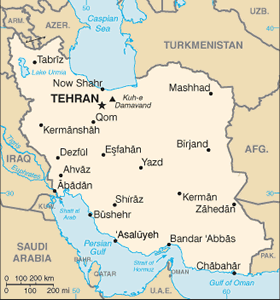The Geography of Iran
The Geography of Iran
Iranian Geography
Location: Middle East, bordering the Gulf of Oman, the Persian Gulf, and the Caspian Sea, between Iraq and Pakistan
Geographic coordinates: 32 00 N, 53 00 E
Map references: Middle East
Area: total: 1.648 million sq km land: 1.636 million sq km water: 12,000 sq km
Area - comparative: slightly larger than Alaska
Land boundaries: total: 5,440 km border countries: Afghanistan 936 km, Armenia 35 km, Azerbaijan-proper 432 km, Azerbaijan-Naxcivan exclave 179 km, Iraq 1,458 km, Pakistan 909 km, Turkey 499 km, Turkmenistan 992 km
Coastline: 2,440 km; note - Iran also borders the Caspian Sea (740 km)
Maritime claims: territorial sea: 12 nm contiguous zone: 24 nm exclusive economic zone: bilateral agreements or median lines in the Persian Gulf continental shelf: natural prolongation
Climate: mostly arid or semiarid, subtropical along Caspian coast
Terrain: rugged, mountainous rim; high, central basin with deserts, mountains; small, discontinuous plains along both coasts
Elevation extremes: lowest point: Caspian Sea -28 m highest point: Kuh-e Damavand 5,671 m
Natural resources: petroleum, natural gas, coal, chromium, copper, iron ore, lead, manganese, zinc, sulfur
Land use: arable land: 9.78% permanent crops: 1.29% other: 88.93% (2005)
Irrigated land: 76,500 sq km (2003)
Natural hazards: periodic droughts, floods; dust storms, sandstorms; earthquakes
Environment - current issues: air pollution, especially in urban areas, from vehicle emissions, refinery operations, and industrial effluents; deforestation; overgrazing; desertification; oil pollution in the Persian Gulf; wetland losses from drought; soil degradation (salination); inadequate supplies of potable water; water pollution from raw sewage and industrial waste; urbanization
Environment - international agreements: party to: Biodiversity, Climate Change, Climate Change-Kyoto Protocol, Desertification, Endangered Species, Hazardous Wastes, Marine Dumping, Ozone Layer Protection, Ship Pollution, Wetlands signed, but not ratified: Environmental Modification, Law of the Sea, Marine Life Conservation
Geography - note: strategic location on the Persian Gulf and Strait of Hormuz, which are vital maritime pathways for crude oil transport


